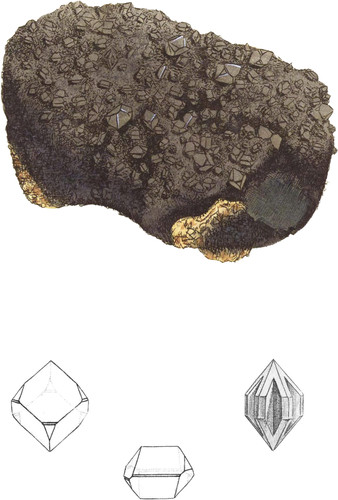 Enlarge
Enlarge
British Mineralogy
Carbonate of Lead
- Class 3. Metals.
- Order 1. Homogeneous.
- Gen. 13. Lead.
- Spec. 2. Carbonate.
- Div. 1. Crystallized.
- Spec. Char. Combined with carbonic acid.
- Syn.
- White lead ore. Kirw. v. 2. 203. Jameson.
- Weisses bleierz. Emmerl. v. 2. 388.
- Mine de plomb blanche. De Lisle, v. 3. 380.
- Plomb carbonaté. Haüy, v. 3. 475.
Carbonate of lead has often a great resemblance to carbonate and sulphate of barytes. It has, however, the advantage of weight, is generally more milky in its appearance, and its mostly shorter in the cross fracture; it is also softer. When crystallized, it is more deceptive, assuming the double pyramidal dodecaëdron of quartz. It is however most readily to be scratched with a knife, which quartz will not admit of; and when carefully examined, there are very few specimens of this sort that do not indicate a very curious tendency to forming one crystal out of many plated ones. These plates are often so placed that is is difficult to see the modification, especially to an unpractised observer. They often imitate the plated crystals of sulphate of barytes. The present specimen is a very fine one, obtained some years since. This shows that they sometimes originate from the decomposition of galæna, and they are here yet coloured with it. The matrix is composed of galæna mixed with fluor. This very curious specimen has the first modification of the quartz-like crystal, deduced from the primitive rhomb (see the left hand outline), with the column just visible: these pass into regular dodecaëdrons, with very short columns, or rather octo-decaëdrons; and also form the same figure in plates, which, if regular, show the surfaces of 12 intersecting planes or facets: see the right hand lower figure: but these are seldom quite regular, and they may be so confused and indeterminate that we cannot make them out: see tab. 90. The under figure is a modification seen on the same specimen, formed by the primitive before spoken of, having a larger deposition on some of the faces than others, which gives it a lengthened appearance.
Analysis by Westrumb:
| Oxide of lead | 81.2 |
| Carbonic acid | 16.0 |
| Lime | 0.9 |
| Oxide of iron | 0.3 |
| Loss | 1.6 |
| 100.0 |

